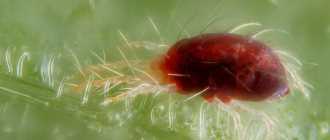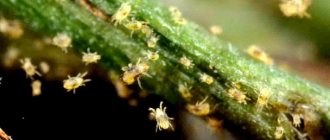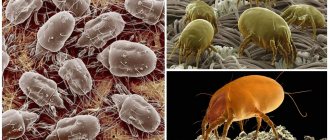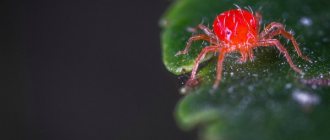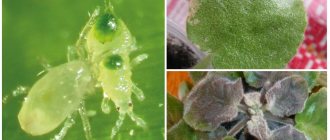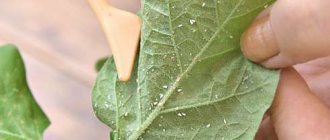Description and life cycle
The Varroa jacobsoni mite is an ectoparasite that lives on bees. It has a very flat body, resembling an inverted oval saucer with protruding lower limbs covered in hairs. The mite's four pairs of legs allow it to crawl and help it stay on the bee.
The body of the female is transversely oval in shape, brown or dark brown in color, measuring 1.6-2 mm. It can be seen with the naked eye. The mouthparts are of the piercing-sucking type and are usually hidden under the body. With its help, the female pierces the chitinous bee covers and feeds on the hemolymph of the blood of adult insects, larvae and pupae.
Among the specific morphological features of Varroa females, the following can be distinguished:
- the presence of a movable part of the peritremal tube, which allows you to regulate breathing in different living conditions;
- a unique body shape that ensures reliable fixation of the mite on the bee’s body;
- the presence of small teeth on the chelicerae directed backwards, which keep the females from falling out of the wound on the host’s body;
- a springy body covering that prevents insects from sticking during their life in bee brood.
The male is smaller and almost round (about 0.8 mm in diameter), visible only in bee brood. Its body has a grayish-white or light yellow tint. The pharynx lacks powerful muscles and is almost invisible. The oral apparatus serves only to transmit the seed during fertilization of the female. There are suction cups at the end of the legs.
The life cycle of the varroa mite consists of the following stages:
- The mother mite (adult female) gets from a worker bee or drone onto the honeycomb.
- The tick climbs into the cell with the larva on the eve of its sealing. This often occurs in drone brood, but it can also occur in bee brood.
- After the cell is sealed (after three days), the female mite begins to lay eggs (an average of 1 egg per day, about 5 in total). The length of the egg is 0.5 mm. A larva develops in it, which turns into a nymph with four pairs of limbs.
- The nymph (protonymph) emerges from an egg measuring 0.7 mm.
- After a one-time molt, the next stage begins - the deutonymph. The dimensions of the female are 1.3 by 1 mm, the male is 0.7 mm in diameter. The chitinous shell is quite soft and whitish in color. They feed on hemolymph.
- While in the cell, the male fertilizes young females, after which he himself dies of starvation. Therefore, only female mites can be seen on adult bees.
- After the young bee has completed its development, it leaves the cell. Ticks move along with her, including an adult female. They climb onto bees (drones and worker bees) and remain on them until the next laying of eggs. Each female tick is capable of laying eggs several times. Young females have a chitinous shell of a lighter shade than adults. Only after a few days does it gradually darken.
The entire development cycle, starting with egg laying and ending with an adult tick, has a duration of:
- in the female – 8-11 days;
- for males – 8-9 days.
In summer, the female lives for 2-3 months, and in winter – about 5 months. In the winter season, due to the lack of brood, varroas stop reproducing and 7-10% of them die.
At the beginning of spring, with the appearance of brood and during the summer, the number of mites in a bee colony increases approximately 20 times. In autumn, when their number in the bee colony decreases, the pests move on to uninfected bees.
Varroa females remain viable outside the bee colony:
- in empty hives on honeycombs – 6-7 days;
- on bee/drone corpses – 3-5 days;
- on pupae – 7-11 days;
- in wax-beebread crumbs – 9 days;
- on honey plants flowers – 1.5-5 days;
- in sealed brood – 30 days;
- in open brood – 15 days.
Females can fast at a temperature of 22-25 °C for up to 5-6 days. At low external temperatures or the presence of harmful substances in the air, the tick stops breathing and hides in the cell of the honeycomb, thereby making it difficult to take measures to combat it.
As a rule, up to 5 mites are attached to one worker, 7-8 females are attached to drones, and 12 and 20 are attached to pupae of worker bees and drones, respectively. Location of parasites:
- between the first and second abdominal segments;
- between the thoracic segments;
- in the joints of the chest and head, chest and abdomen.
Unhindered reproduction of varroa leads to the death of the bee colony after 2-5 years. The more mites in the hive, the sooner the family dies.
The parasite develops well in weak colonies and old dark brown honeycombs.
Treatment
Physical methods of influence
A fairly common method of combating varroatosis in bees is heat treatment. Ticks die quickly at temperatures above 40 degrees. You can almost completely destroy the parasite by keeping it in a heat chamber at a temperature of 45-48 degrees for a quarter of an hour. This method takes quite a lot of time, not only in processing, but also because the bees have to be collected into a cassette. In addition to this, you need to purchase the heat chamber itself or make it yourself.
Also, many beekeepers install trays, mesh tablets, stretchers - paper or cardboard, lubricated with mineral oils - at the bottom of the hives. The goal in this case is to exclude or minimize the contact of insects with mites that have fallen to the bottom. Otherwise, they will again cling to insects.
Chemical methods of exposure
Often, medications for bee varroatosis based on various substances are used for treatment. These may be the following medications:
- Phenothiazine
- Tactician
- Folbex
- Bipin
- Metac
- Dilabik
- Bivar and many others.
Traditional methods
Folk methods of getting rid of ticks include fumigation. Experienced beekeepers use medicinal herbs in this case.
An ordinary apiary smoker is used for fumigation. In this case, you can use dried mushrooms - chaga or rotten mushrooms. Burdock, wild rosemary or dry horseradish leaf are also suitable. Shag, tansy and tobacco will smoke well.
The smoker needs to blow 12-15 large puffs of smoke into the “house” and close it for six hours. This treatment must be carried out every five days.
Another folk method is “medicinal compote”. To prepare it, boil the needles and buds of coniferous trees well, and to enhance the effect, pour in a little garlic tincture. The resulting broth is mixed with sugar syrup in a ratio of 1 to 5 and given to the bees.
Spring treatment
In the first spring months, it is best to use contact methods of exposure. One of these is the installation of plates that are impregnated with acaricide. They should act for one and a half months. For small families (4-5 frames) one strip is installed, for large families - two.
The effect of the medicine begins upon contact with bees. Insects carry microparticles of the product on their hairs and, by touching other insects, transfer it.
Linear annual calendar of a beekeeper
Some beekeepers treat frames with lactic acid. The only drawback of this method is that the air temperature must be at least +14 degrees. 10 ml of 10% acid solution will be enough to treat one frame. The procedure must be carried out twice, taking a break for 10 days.
Another old method of treating varroatosis in bees in the spring is red pepper. It must be poured with boiling water in any quantity and mixed with sugar syrup. Add 20 grams of propolis tincture per 1 liter of the resulting liquid. This feeding must be given to insects three times every week.
Also, spring treatment of bees against varroa can involve installing an anti-varroa mesh in the hive. Its use helps reduce the number of parasites by 30%!
Summer treatment
During the summer months, chemical methods are not used. Typically, beekeepers use medicinal herbs, smoke guns, and evaporators during the honey collection period.
The evaporator must be installed at the top of the frames. Every three days, 96% e(MISSING)tyl alcohol and lavender essential oil are added to it. The device can only be removed after three weeks.
Autumn processing
Autumn treatment of bees against varroa is the most important in beekeeping. Most beekeepers use plates - the most effective way to get rid of varroa mites.
The method of spraying with Bipin also shows no worse results. Every frame and street is treated with the substance. It is very important to maintain proportions here.
In autumn, bees begin to form a club, which indicates close contact between insects. Upon contact, the bees spread the drug among themselves. Thanks to this treatment method, you can destroy 99% of all parasites. Such treatment should be carried out when the outside temperature is above 0 degrees.
Also, in the autumn months a smoke cannon is used. A recipe based on half a glass of purified kerosene and Bipin (5 ml) is perfect. Mix the components until a mass of homogeneous consistency is formed without white sediment. This amount of substance is enough for 50 hives.
Methods of infection
Varroa jacobsoni causes a severe invasive disease of larvae, pupae and adult bees called varroa. This disease is one of the most pressing problems of beekeeping and causes enormous damage to it.
In summer, the mite spreads from sick bees to healthy ones through:
- wandering bees;
- thief bees;
- during apiary migrations;
- families standing on the migration of bees;
- with swarms;
- when buying and selling bees and queens;
- when introducing families with infected brood;
- when bees come into contact with plant flowers;
- during all work on moving honeycombs from one family to another;
- from other insects (bumblebees, wasps);
- during open storage of excised drone brood.
Varroatosis spreads at a speed of 6-11 km within 3 months, which depends on the degree of saturation of the region with bees. First of all, weakened families are susceptible to defeat.
The spread and growth of the pest is significantly higher in areas with hot climates.
In addition to varroatosis, varroa is dangerous due to its ability to transmit pathogens of infectious diseases of bees (American foulbrood, nosematosis, paratyphoid fever, etc.). Mixed diseases accelerate the course of the disease and lead to mass death of bees.
Signs of infection
During the first 2 years the disease develops unnoticed. Then a large number of mites appear (especially in the summer), which infect up to 30% of the bees. Bees and drones have characteristic disadvantages:
- absence or defective development of legs and wings;
- body deformation;
- The brood is variegated in color.
Other signs:
- Bee losses increase sharply, mainly in October-November. During this period, infection increases several times.
- In the autumn-winter period, bees become exhausted faster, as a result, colonies die or emerge from wintering very weakened.
- During wintering, bees behave very restlessly - they make noise and jump out.
- The bottom of the hives is covered with dead bees, on which brown mites can be seen.
- With a high degree of varroa infection, the death of bee colonies begins in the first half of wintering.
- After the main honey collection, upon returning from migration, heavily infected families leave their hives. Even a sufficient amount of food does not stop them.
How to identify a tick infestation
If you are in doubt whether a particular bee or an entire family is infected with a mite, pay attention to the following signs indicating the presence of a parasite.
Firstly, the appearance of a parasite on the body of an insect with a 90 percent probability changes the appearance of its body.
Secondly, the infected insect is unable to function fully and collect nectar and pollen normally.
Thirdly, the presence of a parasite weakens the insect, and therefore it is practically unable to fight the enemy.
And the fourth, most reliable sign is the stop of procreation and the cessation of the appearance of new broods.
Treatment of bees against mites can theoretically be carried out year-round:
- in spring;
- in summer;
- in autumn;
- in winter.
Are there any peculiarities in the method of treating winged apiary workers from parasite attacks depending on the current season of the year? How can the owner of an apiary farm understand that he needs to take urgent measures in order to save his charges?
Treatment must, above all, be effective. If you do everything correctly, then you don’t have to spend all your free time on special measures aimed at destroying the source of the disease.
Experts believe that for preventive purposes, apiary farming needs to be processed annually. However, two sessions will be quite enough: it is best to choose spring and autumn for this.
It is worth choosing the most suitable time for processing. A competent owner of an apiary farm will never disturb his charges in vain.
Spring processing is best done in March. Choose a moment when there is a fairly small amount of honey in the hive, but the winged apiary workers have not yet begun their first spring flight, which usually occurs in late March or early April.
If you are going to process the hives in the fall, then you also need to choose the most appropriate time. It is best to carry out all the necessary activities after the completion of the honey collection.
Winter is considered the most difficult period in the life of an apiary farm, when its winged workers survive the cold in their hive and do not leave it throughout the winter period. Therefore, at this moment it is quite problematic to process bee houses.
In summer, the winged workers of the apiary farm are actively engaged in honey collection. However, it is believed that during this period the activity of parasites is low, and additional measures to destroy them are unnecessary.
In addition, when dealing with the source of the disease, it is worth considering that your patients can be attacked by a wide variety of types of ticks. Accordingly, the consequences of their invasion into the territory of the apiary farm and the measures to combat such a problem differ.
Various acids are often used for processing:
- dairy;
- ant;
- sorrel
In addition, other chemicals may be used. Now you can easily purchase ready-made medications that will help you get rid of your existing problem.
In addition, heat treatment also helps fight the source of the disease. And this option also has a fairly high efficiency: it is no coincidence that it is during the summer season, which is characterized by fairly high temperatures and dry air, that such a problem disappears by itself.
It is recommended to carry out heat treatment mainly in early spring. In this case, exposure to high temperatures must be carried out with the utmost care, otherwise you risk harming the health of your charges.
What temperature should be so that all parasites can die? A temperature of 47 to 48 degrees Celsius is considered sufficient for such purposes.
As you remember, the sources of diseases can come from different varieties. However, the indicated temperatures will be enough to defeat them, regardless of their variety.
During processing, the winged apiary workers must be moved from their usual home to a special cassette equipped with numerous holes. Parasites that died as a result of heat treatment will spill out through these holes.
How to bring the temperature inside the cassette to the desired level? Everything is very simple: to do this, you need to place it in an ordinary bath or sauna.
The heating process will occur in the most natural way. However, remember to adhere to the time frame: before placing the cassette in a warm room, note the time.
Remember that the cassette should not be kept in a place with high temperature for more than 12-14 minutes. During heat treatment, periodically shake the cassette so that dead parasites can spill out of the special holes.
It is also worth moving your wards back to their home in stages. First, transfer the cassette from the bathhouse or sauna to a room characterized by ordinary room temperature.
Be sure to keep your charges there for at least 15 minutes. And only then can they be transferred to open space and again placed in the familiar conditions of their native hive.
The most popular types of parasites that most often affect winged apiary workers are the tracheal mite and the varroa mite, also known as the gamagas mite. Each of them causes its own special disease: in the first case we are talking about acarapidosis, and in the second - about varroatosis.
Fighting methods
To combat the mite, a whole range of measures should be carried out, which includes general organizational, special beekeeping and veterinary measures. It is necessary to comply with the conditions of keeping, feeding, breeding bees, as well as apply zootechnical methods to combat varroa and systematically carry out anti-acaricidal treatments.
Pest control must continue annually and comprehensively.
It is very important to reduce the number of mites after the last honey pumping. This way, the bees that hatch and will spend the winter can live with minimal levels of infection. At the same time, the degree of stress when feeding bees is also reduced. The next treatment will be most effective after the end of brood hatching (in winter). In the spring, to reduce the number of pests, the method of cutting out drone brood is used.
Conventionally, measures to combat these parasites can be divided into 2 groups.
Medication
When using chemicals, you should adhere to the following basic recommendations:
- It is prohibited to use drugs before or during honey collection. In many regions, processing in the spring is associated with risk, since honey harvest often begins earlier than planned. As a result, chemical residues remain in the honey.
- Use only approved medications (failure to comply with this rule is punishable by quality control authorities and is determined by diagnosing beekeeping products for the presence of drug residues in them). For example, formic acid can only be used in the form of Illert tiles, even though other forms are more effective and better tolerated by bees.
- Before use, be sure to carefully read the instructions.
- Honeycombs that are in the hive during processing (except formic acid treatment) cannot be used as honeycombs. They need to be melted as quickly as possible.
- During pumping, it is necessary to separate the wax particles (through a sieve, gauze) from the honey, as medications may get into it.
On the eve of each treatment, the hive is placed in a tray, using two options:
- through a hinged cover at the back, or a large entrance;
- lifting the lower body (the bees begin to worry).
But, the most suitable option would be a mesh bottom with a tray underneath. While controlling such a tray, the bees remain calm. It is necessary to try not to disturb the bees at all before treatment.
Chemicals are used that destroy or severely damage ticks. Medicines evaporate in the hive, are fed to the bees and act through their blood. It is also possible to act when bees come into contact with the medicine (through the strips on which they crawl).
Let's look at some of the acceptable medications.
1Pericin
The action of this drug is carried out through the blood and is aimed at parasites that are not in the brood, but directly on the bees. It should be used exclusively in the dry winter season (twice with a break a week, unless combined with additional medications). Application is permissible at 0 °C or at slightly sub-zero temperatures.
Pericin is fat soluble, so its particles remain in the wax and honey.
Consumption:
- for a family in two buildings - 25-30 ml of emulsion;
- in one body (or layers) – 20 ml.
The amount depends on the size of the family, but most often the recommended dosage of 50 ml in the instructions turns out to be too much. Bees can be treated with pericin solution using either a special dosage kit or a disposable syringe.
2Apitol
This drug is water soluble and easily penetrates honey, so you should proceed with caution.
It is strictly prohibited to combine Apitol with food and use it during feeding.
This remedy should be used in cases where ticks have developed resistance to previously used drugs. Treatment is carried out at low air temperatures during non-fertile times. Apitol goes on sale in powder form, which must be dissolved in a large amount of liquid.
3Formic acid on Illert tiles
The method is based on the evaporation of formic acid from the surface of the tile, which then penetrates the mites with the air entering the hive, thereby affecting them externally. The drug must be used in the evening with the taphole open, at an air temperature within +12…+20 °C.
It is prohibited to use the drug during honey collection.
If you do not combine this method with others, the frequency of treatment will be 3-4 times with breaks of a couple of weeks.
Before treating with formic acid, it is necessary to clean off the wax bridges from the top strips of the frames. Then you should pour smoke over the honeycomb so that the queen is at the bottom. In hives, one tile is placed on the frame per frame; in double-hull hives, two tiles are placed on the frame. After which the hive is closed. If the tiles are too thick, place an empty extension on top.
It is possible to get a negative effect - there is a risk of losing the uterus.
When working with Illert tiles and formic acid, be sure to wear waterproof gloves and safety glasses.
4Cecafix
The use of this remedy is similar to pericin. However, the advantage of Cecafix is that it is better tolerated by bees.
5Bayvarol
The product consists of special strips that are suspended along the perimeter of the central span between the honeycombs (4 pieces per family in double-hull hives). Contact with bees occurs through close contact with the strips. The manufacturer recommends leaving bayvarol to act for 6 weeks, but this may lead to excessive concentration of the drug in the wax. Therefore, the optimal period for keeping the strips in the hives is 3 weeks.
Work should be carried out with gloves. It is necessary to take care of the correct disposal of bayvarol, since it is forbidden to throw the strips into the trash or into water bodies.
Biotechnical
The essence of these methods is that the beekeeper, in order to destroy mites, interferes with the course of their biological development. These include:
- Drone Brood Excision - Destroys certain combs containing printed brood (drone brood) where female mites lay their eggs. As a rule, drone brood is frozen for this purpose. The use of this method should begin in late March - early April.
- Destruction of a honeycomb trap with a queen locked in it. The queen is placed three times in turn for 10 days on an empty honeycomb in a frame cage. Thus, the uterus worms inside the cell. Within 10 days, no open brood remains outside the cage with the queen, and the mites move to the open brood of the honeycomb trap for the purpose of reproduction. This brood is destroyed (frozen).
- Heat treatment of honeycomb traps or all honeycombs with brood - heating occurs to a temperature harmful to mites, but acceptable for bees. This method is effective but labor-intensive.
Medicinal and biotechnical control methods can be successfully used in combination. Their combination will help keep the number of mites at a harmless level and will compensate for the shortcomings of individual methods. Wherein:
- the amount of medications used is reduced;
- the content of chemical residues in wax and honey is reduced;
- the number of mites is reduced to an acceptable value.
Each beekeeper should think over his own pest control strategy, which will depend on the design features of his hives, bee keeping technology, climate and food supply.
Treatment of varroatosis with home methods
It has been proven that chemicals affect the mite, but do not completely get rid of it and can harm the bees. Therefore, in addition to them, it is worth paying attention to other methods of control that beekeepers have used since ancient times. There are many treatments for varroatosis, but it is best to use traditional methods:
- Pine needle extract is a remedy available to everyone; for it you need to take honey, if not, then sugar, add a teaspoon of pine needle extract.
- Beekeepers often use CAS 81, to prepare it you will need pine buds - 50 grams, wormwood - 50 grams, wormwood color - 1 kg, mix everything thoroughly, boil for about 3 hours. Leave for 10 hours, strain through a sieve. Then mix with sugar syrup and give to the bees. One family should consume about 6 liters of syrup; it should be given in early spring, late summer, or in the fall.
- Treatment with garlic and nettle will help get rid of varroatosis. For it you will need garlic - 10 ml, red pepper infusion - 30 ml, prepared earlier by KAS81, add the mixture to sugar syrup and give it to the bees in the spring.
- Infusion from spruce and juniper needles. It is necessary to grind the plant, pour boiling water, leave for about two hours, add sugar. Bees should consume it for up to 10 days. The needles must be ground in a blender to obtain juice from them. Then take sugar syrup - 1 liter, add juice - 2 ml. One family needs 6 liters of syrup per day.
- Varroatosis can be cured with a decoction containing motherwort, calendula, and chamomile. Boil everything for 50 minutes. Wait until it cools down. Then dilute in one liter of sugar syrup. Give to bees in the fall.
- You can prepare an infusion of pepper; you will need 50 grams of capsicum and half a liter of boiling water. Leave everything for about 3 hours, strain, add sugar syrup. Give to bees in spring. Beekeepers also use this recipe: you need to take 10 grams of ground pepper, 100 ml of boiling water, pour everything in and leave for about 3 hours. Then spray the insects.
- Potatoes help against varroatosis. It is necessary to wash the potatoes and leave them in the sun. After peeling the potatoes and finely grating them, add honey. The mixture is wrapped in gauze and placed on the frame. It is not necessary to add honey to the product.
- Bird cherry will help fight varroatosis; you will need to find the shoots and carefully arrange them in frames, after wrapping them in gauze.
- Dill oil with Vaseline must be applied to clean paper in thin layers. Leaves settle up and down. This must be done three times. In case of high temperatures, one leaf is enough and bees can be seriously poisoned due to fumes. You will need 3 grams of the mixture, add it to a liter of sugar syrup. You can buy ready-made dill oil or buy it yourself. To do this, you will need to grind 400 grams of dill seeds, add sunflower oil - 150 grams. Leave for a day.
- Thyme is also an effective remedy in the treatment of varroatosis. First you need to chop the thyme that blooms, put everything in cheesecloth and arrange it in frames, cover it with plastic on top. If you notice that the medicine begins to dry out, you need to change it.
Beekeeping for beginners - Varroatosis can be treated with vegetable oil. You need to mix sunflower, camphor, dill oils, add a little mint infusion, you can use lemon balm. Processing is carried out up to three times.
- For treatment, it is recommended to use a fern, divide it into two parts, one for the ceiling, the other for the frame. When the bees completely gnaw off the leaves, a specific smell will appear, due to which the mites begin to fall off.
- Spraying with whey. You need to do this for three days in a row.
- Beekeepers use turpentine ointment for treatment; it must be applied to paper and placed at the bottom of the hive. When the ointment begins to evaporate, it will release hydrogen peroxide, and the ticks will die from it.
- Using pine flour to pollinate the colony, this should be done in early spring, when there is no or little brood in the hive.
- Formic acid is often used. In order not to harm the bees, you need to take cardboard and dip it in acid, cover it with polyethylene on top, and place it on the frames. You can use formic acid in another way. To do this, take a bottle, place 40 ml of acid in it, and then insert the wick. The product must be placed on the walls of the hive.
Types of beekeeping products, their use by humans
Prevention measures
To reduce the harm caused by the varroa mite, various preventive measures should be taken:
- Acquired families and captured swarms must be treated at least once (for example, the swarm with pericin, and the rest with formic acid). Based on the number of parasites on the pallet, a decision is made about the need for further treatment.
- Regular inspections of the tray and drone brood should be carried out for the presence of parasites.
- It is extremely important to coordinate treatment against varroa with neighboring beekeeping farms to obtain a good result and to avoid re-infestation.
- Apply control methods regularly, and do not miss the periods most suitable for their implementation.
- Periodic cleaning and disinfection is required. Following normal hygiene rules will help protect you from mixed diseases.
- It is necessary to reheat the honeycombs in a timely manner.
The characteristics of the varroa mite, analysis of mites on larvae and adult bees, treatment methods, medications to combat the pest and the time of their use are described in detail in the video:
Varroa mites are dangerous pests that cause a fatal disease that causes serious complications in the apiary. However, today there are a large number of ways to both combat attacking parasites and prevent their appearance and spread.
0
0
Copy link
